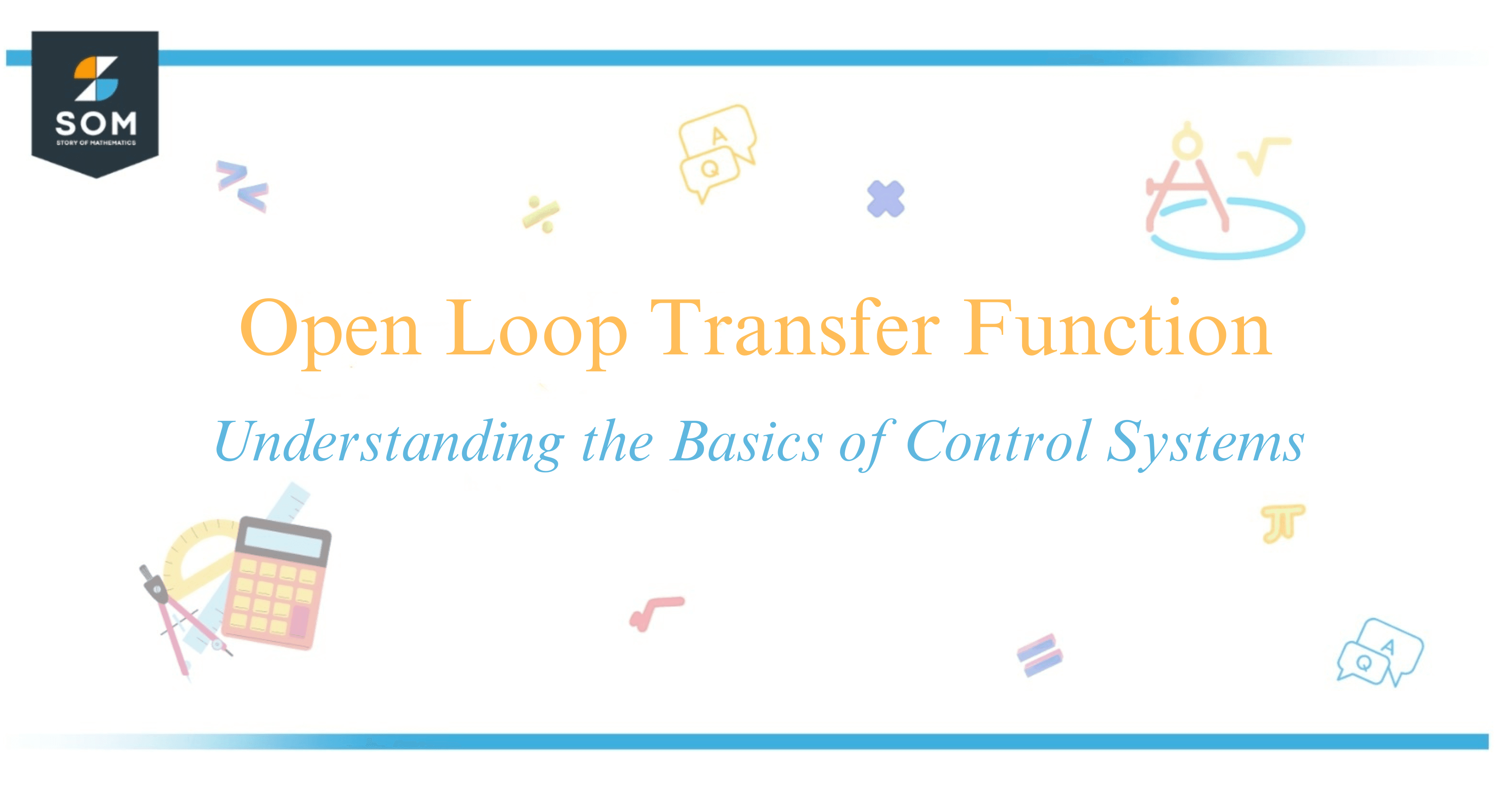JUMP TO TOPIC

An open loop transfer function in a control system is a mathematical expression that represents the relationship between the input and the output of a system before the application of feedback.
Generally speaking, it’s given as the ratio of the output of the Laplace Transform to the input Laplace Transform under the assumption that all initial conditions are zero. This is depicted by the formula $\frac{Output(s)}{Input(s)}$.
Without the influence of feedback, such a model provides insight into the inherent behavior of the system’s components; it is a straightforward means to understand the system’s dynamics.
When considering complex systems, the open loop transfer function allows engineers to predict how a system will react to a given input.
It’s essential for designing the system and establishing the base performance before adding control loops and feedback to improve stability and accuracy. Stay tuned as we look into how these functions are not just a theoretical concept, but a cornerstone in the world of engineering.
Fundamentals of Open Loop Control Systems
An open-loop control system is the simplest form of control in automation. When I design such a system, I aim for a straightforward process where the output is not compared against the desired performance.

Think of it like telling a friend to walk straight for ten seconds—there’s no adjustment if they veer off; they just continue for the allotted time.
In my block diagram, an open loop system has a clear direction of signal flow: from the input, through the controller, and finally to the output without any feedback.
The transfer function—which I denote as $ G(s) $—describes how the output behaves with respect to a given input when operating in the frequency domain.
Moreover, the open-loop frequency response can indicate how the system will perform over a range of frequencies. Here’s a simplified representation of an open loop system in a block diagram format:
| Input Signal | → | Controller | → | Output |
|---|---|---|---|---|
| Represents the desired action | Determines the system’s action | The result with no feedback |
The beauty of an open-loop controller is its simplicity. I appreciate it because it’s easy to design and maintains low costs. However, it’s not without drawbacks. Since there’s no feedback mechanism to correct errors, any disturbance or changes in the system can lead to performance drift.
In summary, I might choose an open loop when precision is not as critical, or when it’s impractical or costly to measure outputs. It’s a “set it and forget it” approach—useful, but limited by its inability to adapt or correct itself.
Analyzing Transfer Functions
When I approach the task of analyzing transfer functions, I focus primarily on understanding the system’s response to various inputs. The transfer function itself represents the system’s response in the frequency domain and is pivotal in predicting behavior without solving the differential equations in the time domain.
Firstly, to calculate a system’s transfer function, I use this standard equation:
$$ L(s) = \frac{N(s)}{D(s)} $$
Here, ( L(s) ) represents the transfer function, ( N(s) ) the numerator polynomial, and ( D(s) ) the denominator polynomial in terms of the Laplace variable ( s ).
The roots of the denominator, known as poles, are crucial since they determine system stability. A system is typically considered stable if all its poles are in the left half of the complex plane (have negative real parts).
To better understand the frequency characteristics, I often generate a Bode plot, which illustrates the system’s frequency response. It’s a graphical representation that shows how the system’s gain and phase shift vary with frequency.
Studying the characteristic equation of a system, which is derived from the denominator ( D(s) ) of the transfer function, allows me to deduce the natural frequency and damping ratio—parameters that describe the system’s transient response.
Here’s a summarized process for analyzing transfer functions:
- Determine the transfer function ( L(s) ).
- Identify the system poles and stability from the characteristic equation.
- Plot the Bode plot for visualizing the system’s frequency response.
- Extract key parameters like natural frequency and damping ratio.
| Step | Description |
|---|---|
| Calculate | Obtain $L(s) = \frac{N(s)}{D(s)}$ from system dynamics |
| Poles | Determine system stability from roots of ( D(s) ) |
| Bode Plot | Graph gain and phase vs. frequency |
| Parameters | Find natural frequency and damping ratio |
In summary, by analyzing transfer functions methodically, I can uncover a wealth of information about system behavior, aiding in the design and prediction of control systems’ performance.
Comparing Open and Closed-Loop Systems
The main differences between open-loop and closed-loop systems are rooted in their feedback mechanisms and the way each handles errors.
Open-loop systems operate without feedback, leading to a fixed, predetermined output, while closed-loop systems utilize feedback to adjust their responses continually.
In open-loop systems, the open-loop transfer function defines the relation between input and output without accounting for feedback. It’s represented as ( G(s) ) where ( s ) is a complex variable in the Laplace transform domain.
Open-loop systems follow a simple principle: the controller applies a command, and the system reacts proportionally without evaluating the outcome. Such mechanisms are beneficial when the conditions are constant, and high precision is not required.
On the contrary, closed-loop systems are designed to minimize error and improve stability. They incorporate negative feedback to compare the actual output with the desired output, adjusting the input accordingly.
The closed-loop transfer function illustrates the system’s behavior when feedback is considered and is expressed as $\frac{G(s)}{1+G(s)H(s)}$, with ( H(s) ) being the feedback path’s transfer function. These systems deliver a more accurate closed-loop response and are better equipped to manage disturbances.
When observing the step response – the output’s reaction to a sudden change – it’s evident that closed-loop systems exhibit a more refined and stable behavior over time due to their corrective feedback loop, as opposed to the typically static response of open-loop systems.
Practical Applications and Advanced Tools
In the realm of control theory, open-loop transfer functions are fundamental in the design and analysis of control systems. These transfer functions represent the mathematical relationship between an input signal and the system’s output without feedback.
To optimize the performance of systems such as motors or any form of actuation systems, the application of PID controllers comes into play.
I use tools like MATLAB for simulating control systems. Here, the root locus method is particularly helpful. It plots the roots of the denominator polynomial as a function of a parameter, such as gain, on the complex plane.
This helps in determining the range of gain values that lead to system stability by observing the changes in asymptotes and phase margin.
Phase Margin: It is the amount of additional phase lag at the gain crossover frequency that will bring the system to the verge of instability. Mathematically, it’s given by the expression $ \text{Phase Margin} = 180^\circ + \phi_c $ where $ \phi_c $ is the phase of the open loop transfer function at the crossover frequency.
Root Locus Real Axis Asymptotes: Given the difference in the number of poles and zeros ($P-Z$) in a system, the asymptote angles are calculated by $ \theta = \frac{(2k + 1)180^\circ}{P-Z}, \ k=0,1,\cdots, P-Z-1 $.
A dynamic model can be significantly refined by including a finite zero in the transfer function, which adds a term in the numerator polynomial. This provides a more accurate representation of the system’s transitory response.
Here’s a table illustrating key components in these systems:
| Component | Role in System | Mathematical Relevance |
|---|---|---|
| Poles | Determine system stability | Roots of denominator polynomial |
| Zeros | Impact transient response | Values where the numerator is zero |
| PID Controller | Improves system response | Adjusts coefficients of the dynamic model |
To ensure stability and achieve desired system dynamics, I also consider the asymptotic behavior of the poles which can be observed through the root locus plot.
My focus always remains on achieving a balance between response speed and stability, ensuring motors and other systems function within their optimal parameters.
Conclusion
In exploring the role of open-loop transfer functions in control systems, I’ve highlighted their fundamental importance in understanding system behavior before feedback is applied.
The ratio $\frac{B(s)}{E(s)}$ reflects the transfer function, providing insight into how specific system configurations respond to various inputs.
Through my examination, it’s evident that the roots of ( NG(s)NH(s) = 0 ) represent the finite zeros, while the roots of ( DG(s)DH(s) = 0 ) determine the poles of the open-loop transfer function. Both zeros and poles are crucial as they inherently impact stability and system dynamics.
Furthermore, the creation of Nyquist and Bode plots from the open-loop transfer function allows for a graphical representation of the system’s response, facilitating the analysis of potential stability when the loop is closed.
It’s my understanding that these techniques are vital for engineers who aim to predict the behavior of control systems under various conditions.
This foundational knowledge serves as a stepping-stone for more advanced system analysis, such as determining the adequacy of voltage-mode control through the open-loop transfer function of devices like the PWM buck-boost DC-DC converter.
Engaging with these concepts allows me to foresee how modifications in system design can optimize performance and stability. By sharing this knowledge, I hope to support fellow enthusiasts in further demystifying the intricate world of control systems and their transfer functions.
